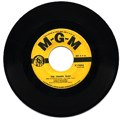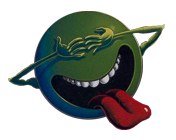How has the record industry changed in the last 50 years? Using the Whitburn Project spreadsheet I talked about yesterday, I’ve been trying to dig into some of the underlying trends. Today, I’ll be tackling the longevity and diversity of pop songs, and a look at which decades had one-hit wonders.
Longevity of a Pop Song
One of the trickier questions I’ve been trying to visualize is how long pop songs are staying on the charts relative to the past. Are they staying on the charts longer than in the past?
In the chart below, I plotted the total number of weeks charted for all 23,924 songs that appeared on the Billboard Hot 100 from 1957 to earlier this year. (In other words, a little dot on the “60” line means there was a song released that week that stayed on the Hot 100 chart for 60 weeks.)
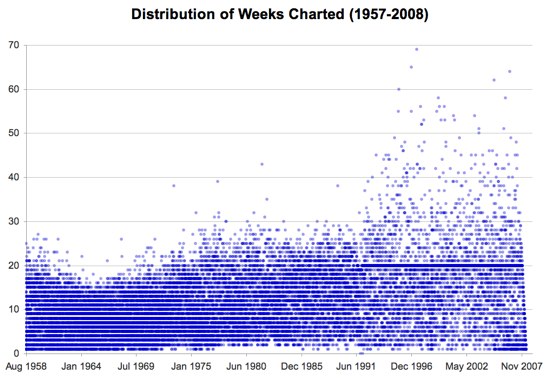
See the heavy dropoff on the 20th week starting in 1991? In an attempt to increase diversity and promote newer artists and songs, Billboard changed their methodology, removing tracks that had been on the Hot 100 for twenty consecutive weeks and slipped below the 50th position. These songs, called “recurrents,” were then moved to their own chart in 1991, the Hot 100 Recurrent.
Unfortunately, this shift makes it much harder to compare the last 15 years to the decades before it. In the chart below, I’ve isolated the effect by only showing songs that reached the top 50.
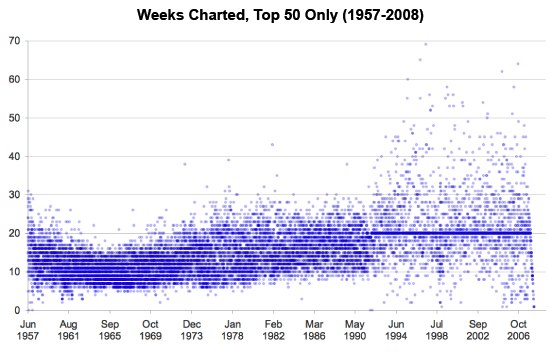
A couple interesting observations… Looking at the very bottom of the chart, you can see that in the last couple years, it’s become very common for a single to appear in the Top 50 and fall out of the Hot 100 within four weeks. Prior to the mid-1990s, this almost never happened.
Also, songs are staying in the Top 50 for far longer than they used to. Unfortunately, I don’t have any actual sales numbers to compare to, so it’s hard to say if these 30-70 week singles are massive megahits eclipsing the #1 singles of the past, or if it’s because the record industry is producing fewer hits than before.
Diversity
Did Billboard’s methodology changes in 1991 make the charts more diverse, like they hoped? By looking at the total number of unique songs that have charted yearly, it’s clear their changes did nothing to slow the decline.

According to Billboard, the late 1960s were the peak of musical diversity in popular music, with 743 different songs appearing on the 1966 Billboard Top 100. It’s fallen consistently since, hitting an all-time low in 2002 with only 295 songs. Since then, it’s improved only slightly, with 351 unique songs appearing on last year’s Top 100.
One Hit Wonders
I’ve always thought the 1970s were the decade of the one-hit wonder, but now I have the data to see for sure.
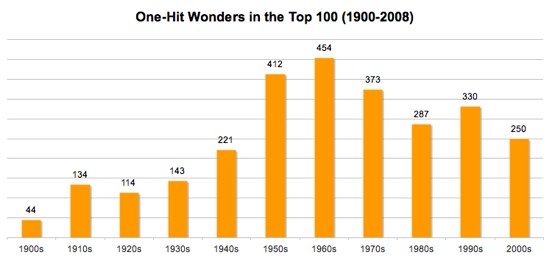
In raw numbers, the 1960s had more one-hit wonders than any other decade, followed closely by the 1950s. But that’s not entirely fair since, as we saw earlier, there were simply more unique songs on the 1960s charts. To find out the true numbers, we need to look at the number of one-hit wonders as a percentage of all songs in the Top 100.
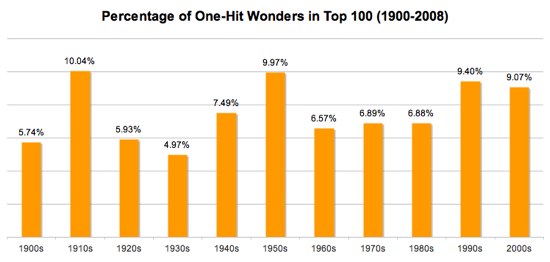
This tells a totally different story. The 1960s, 1970s, and 1980s all had about the same ratio of one-hit wonders to hits by more established artists. The big surprise for me is that 1950s, 1990s, and 2000s really seem to be the eras where one-hit wonders dominated the charts.
Joshua Porter was wondering about the longest-charting one-hit wonders of all time. The longest-charting one-hit wonder to hit the #1 spot is Daniel Powter’s “Bad Day” from 2006, which stayed on the charts for 32 weeks. The one-hit wonder that stayed at the #1 longest is Anton Karas’ “The Third Man Theme” from 1950, which stayed in the #1 position for 11 weeks. Finally, the longest-charting one-hit wonder to appear anywhere in the Top 100 is Duncan Sheik’s “Barely Breathing” from 1997, which peaked at #16 but stayed in the top 100 for 55 weeks.
Have any other questions about the data, or done any analysis yourself? I’d love to hear about it.
May 20: Don’t miss Mike Frumin’s chart of pop longevity,from 1998-2002.
May 21: Using the Whitburn data, Tom Whitwell generated a tag cloud showing the top 100 commonly-used words in song names. Dianne Warren should write a #1 hit called “Love my Baby Blue Heart: A Girl’s Night Song.”
July 14: Pedro did some additional analysis, including artists with multiple hits in the same week and one-week wonders.

